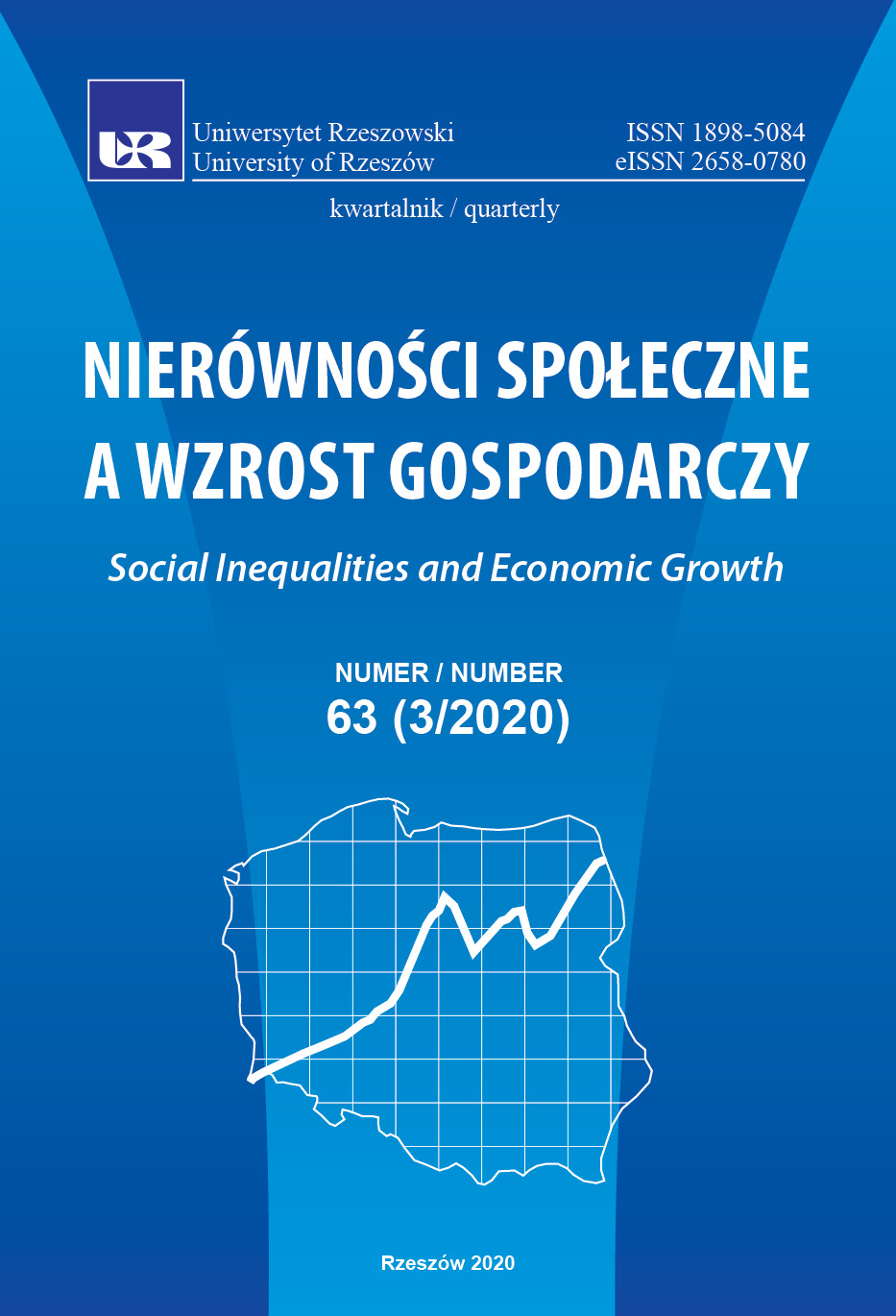Salaries and the logic of national income distribution in a market economy – described using a simple model
DOI:
https://doi.org/10.15584/nsawg.2020.3.4Keywords:
GDP distribution, wages, money, exports, imports, smile curveAbstract
The level of prosperity available is the value of what is produced in the economy. This is a general truth, while the level of well-being of community members is a consequence of the value added and the rules and mechanisms of national income distribution. The purpose of the paper is to show the macroeconomic principles of the division of the generated GDP value, based on the example of a simple model of the economy in a classic style: the economy is presented as the Great Bakery, which produces loaves of bread shared between employees and its owner, the Baker. The author uses this model to demonstrate the consequences of the division of the generated surplus, which is the Baker’s profit from three sources: development-oriented investments and the savings associated with them, the public sector and exportation. The author shows the structural consequences of reducing wages and shifting the tax burdens to the employees. He proves that the reduction of labor costs should be accompanied by an increase in the tax burdens imposed on companies – the Baker in his model. These rules of division have macroeconomic consequences and the author shows the effects for Poland’s position in a group of countries, presented as international comparisons (mainly OECD countries). The author shows that one of the key factors determining prosperity is the place of industry in the product development cycles produced by the global division of production. The amount of added value obtained at various stages of these production cycles is illustrated by the so-called smile curve. The author shows the international division of labor has led to the location of the industries of post-communist countries, including Poland, around the minimum of this curve. This causes the average level of wages and, consequently, welfare to be low. The analysis leads to the conclusion that a policy of structural changes is needed, one that will shape this division so that the country regains full production cycles and thus strengthens its economy. The author discusses the simplified thesis formulated by Jeffrey Sachs that sustainable development is the most important for prosperity. The author justifies the thesis that it is not so much development as the amount of added value generated by industry and the mechanisms of its distribution, and points out that, as Justin Yifu Lin observes, it is the structural changes which will lead to an increase in added value and modifications in the principles of its distribution, so as to increase social well-being.
Downloads
References
Dobija, D. (2003). Pomiar i sprawozdawczość kapitału intelektualnego przedsiębiorstwa. Warszawa: Wydawnictwo Wyższej Szkoły Przedsiębiorczości i Zarządzania im. Leona Koźmińskiego.
Dobija, M. (2008). Labor productivity ratio and international comparison of economic performance – Formalization of the PPP theory and preliminary examinations. Journal of Transforming Economies and Societies EMERGO, 13(1), 3–19.
Eurostat. Retrieved from: http://appsso.eurostat.ec.europa.eu/nui/show.do?lang=en&data¬set=ilc_di12 (2020.06.10).
Galbraith, J. K. (2018). Gospodarka niewinnego oszustwa. Prawda naszych czasów. Warszawa: MT Biznes.
Goldman Recruitment Salary Survey 2018. Retrieved from: www.goldmanrecruitment.pl (2020.06.10).
Harari, Y. N. (2014). Sapiens – Od zwierząt do Bogów. Warszawa: Wydawnictwo Literackie.
Kalecki, M. (1986). Teoria dynamiki gospodarczej. Warszawa: PWN.
Keynes, J. M. (1985). Ogólna teoria zatrudnienia, procentu i pieniądza. Warszawa: PWN.
Levinson, M. (1992). Nie tylko wolny rynek, Odrodzenie aktywnej polityki gospodarczej. Warszawa: PWN.
Lin, J. Y. (2017). Nowa Ekonomia Strukturalna dla gospodarek doganiających. In: J. Y. Lin, A. Z. Nowak (Eds.), Nowa Ekonomia Strukturalna wobec krajów mniej zaawansowanych (pp. 199–219). Warszawa: Wydawnictwo Naukowe WZ UW.
Łaski, K. (2015). Wykłady z makroekonomii. Gospodarka kapitalistyczna bez bezrobocia. Warszawa: PTE.
Moździerz, A. (2018). Paradygmat deficytów bliźniaczych a doświadczenia krajów Europy Środkowo-Wschodniej. Warszawa: PWE.
Nowak, A. Z. (2017). Nowa Ekonomia Strukturalna a dylematy rozwoju gospodarki. In: J. Y. Lin, A. Z. Nowak (Eds.), Nowa Ekonomia Strukturalna wobec krajów mniej zaawansowanych (pp. 235–248). Warszawa: Wydawnictwo Naukowe WZ UW.
Owsiak, S. (2002). Finanse Publiczne, Teoria i praktyka. Warszawa: PWN. Roczniki Statystyczne. (chosen years). Warszawa: GUS.
Smith, A. (2003). Badania nad natura i przyczynami bogactwa narodów. Warszawa: De Agostini, Altaya.
Thurow, L. C. (1997). The Impact of Taxes on the American Economy. New York: Praeger Publishers.
FRED Economic Data Economic Research Federal Reserve Bank of St. Louis. Retrieved from: https://fred.stlouisfed.org/graph/?g=dZn (2020.06.10).
World Bank Broad. Retrieved from: https://data.worldbank.org/indicator/fm.lbl.bmny. gd.zs (2020.06.10).
Woźniak, M. G. (2019). Gospodarka Polski 1918–2018, W kierunku zintegrowanego rozwoju, vol. 1. Warszawa: PWN.
Żyżyński, J. (2009). Budżet i polityka podatkowa. Wybrane zagadnienia. Warszawa: PWN.
Żyżyński, J. (2014). Pieniądz egzogeniczny jako baza dla emerytur kapitałowych. In: J. Czekaj, S. Owsiak (Eds.), Finanse w rozwoju gospodarczym i społecznym. Warszawa: PWE.
Downloads
Published
How to Cite
Issue
Section
License
Copyright (c) 2020 University of Rzeszow

This work is licensed under a Creative Commons Attribution-ShareAlike 4.0 International License.


